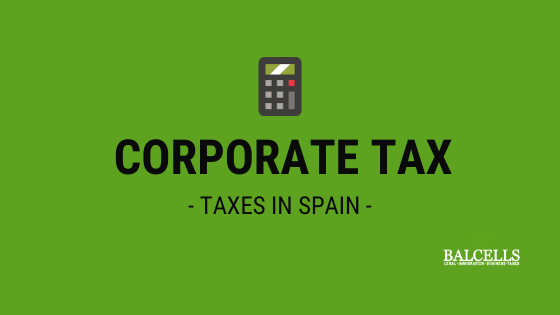If you are here it is because you are considering opening your own business and would like to understand your tax obligations in detail, or because you already have one and want to optimize your taxes. Whatever the situation, you will find the answer in this guide. Here you will find all the information you need to understand once and for all how corporate tax works in Spain. We will see exactly what the tax law says about it, when and how it is paid, and most importantly: how to save money and pay less. Let’s get started!
What is the corporate tax in Spain?
Corporate tax is the tax paid by companies in Spain on the profits it generates. It is the equivalent of the income tax paid by the self-employed individuals or employed workers, but for companies or legal entities.
This tax rate is designed for companies or firms resident in Spain. In the case of non-residents, they will be taxed at a different rate.
That is, if your registered office and your operations take place in Spain, you will have to pay this tax.
Focusing on companies established in the Spanish territory, we can say that this is a state tax. This basically means that it is exactly the same in all Autonomous Communities (except Navarra and the Basque Country).
As for all corporate business structures (as opposed to individual ones), they all pay corporate tax. Here you can find a list of all the different existing corporate companies.
The consolidated legislation regulating this tax is Law 27/2014, published in the BOE on November 27.
The institution in charge of collecting the tax, and to which you will have to respond in this regard, is the Spanish Tax Agency.
What is the corporate tax rate in Spain?
It will depend largely on the type of company and activity. However, at a general level, the corporate tax rate consists of 25% on profits.
The main advantage of the corporate tax is that it is not progressive.
In other words, unlike the taxes paid by self-employed workers, in the case of companies, it is a fixed rate that does not increase as turnover increases. In other words, it will always be the same regardless of what you earn.
That is why we recommend that if you expect to earn more than 60,000 euros a year, do not hesitate and start directly with the company path.
But there are many nuances, and these percentages vary according to the type of company:
- Standard corporate tax rate: 25%
- Micro-enterprises (with a turnover < €1M): 21%, where higher rates apply for excess income
- Small & medium-sized enterprises (turnover from €1M – €10M): 24%
- Newly created companies: 15% (during the first two profitable years)
- Start-up companies: 15% (first profitable year + next three years)
- Banks & credit institutions: 30%
- Tax-protected cooperatives: 20%
- Non-profit organizations & foundations: 10%
- Canary Islands special zone (ZEC) entities: 4%
- Large corporations (turnover ≥ €20M): Minimum 15%
- Multinational groups (revenue ≥ €750M): Minimum 15% (Global Minimum Tax)
As you can see, and perhaps most interestingly if you are thinking of setting up your own business, you will receive a tax incentive to do so.
In the first year you register a positive result or profit and in the following year, you will only pay 15%.
However, if you have been working as a self-employed person, you will not be able to benefit from this reduction and you will pay the usual 25%.
We recommend that you send us an e-mail to [email protected] so that we can analyze your case in detail and decide whether you can benefit from a reduction in the rate or not.
On the other hand, there are certain expenses and investments that you can deduct, and that undoubtedly makes this option attractive.
We will explore this later on.
But not everything is positive. The downside of having to pay tax as a company is the need to be much more precise with your accounting.
This will require much more work and time than if you were to set up as an individual entrepreneur, so a tax advisor will be 100% necessary.
You can access a more extensive comparison in our article in which we analyze what to consider when deciding whether to set up as a self-employed person or as a company.
Business tax according to the type of company
As we have just mentioned, although the tax in its general rule is 25%, this will vary depending on the activity and type of company:
- If the company is for-profit, the rate will range from 15 to 30%.
- In the case of foundations and associations, it is 10%.
- For non-profit organizations or cooperatives, 20%.
- Other activities, such as investment funds or sicav, they enjoy a reduced rate of 1%.
- And finally, pension funds are taxed at 0%.
How to pay less corporate tax
Good news. No matter what tax bracket you are in depending on the type of your business, you can reduce that percentage and pay less.
How?
In the following section you will understand this perfectly. But for now, you should know that the government, in order to encourage certain business activities, allows the deduction of certain items.
For example, if we are talking about investments in R&D or technology, or the hiring of certain worker profiles, you can reduce your percentage.
Anything that is innovative in your sector or industry can be deducted from this tax. And it can be as simple as investing in the creation of an app or website.
How to calculate corporate tax in Spain?
This may be the most complex section. But we will explain it to you step by step in the easiest possible manner.
In general, the exact amount to be paid on business tax is calculated by applying the corresponding percentage (which we have already seen varies according to the activity/company) to the difference between the company’s income and expenses. That is, to its profits.
However, how we arrive at those profits is a little more complex than simply subtracting the expenses from the income. And once we have the profit, there will be other items that will make the final amount payable go up or down.
Let’s look at that.
1. Compute the company’s accounting profit
The first thing we will need is our accounting result, obtained in the income statement. It must obey the rules pointed through the Spanish General Accounting Plan.
The accounting result is the difference between income and losses recorded during the financial year.
This will be our starting point for calculating the total amount payable.
Although it is true that the tax regulations accept it as a basis, we will still have to make certain adjustments.
2. Get the tax result
We will then apply the extra-accounting adjustments to the accounting result, thus obtaining the tax result to which we could apply the corresponding corporate tax in the absence of other assumptions.
That is, we actually pay tax on the tax result, not on the accounting result.
Through these adjustments, we subtract or add to the accounting result all the expenses that accounting incorporates in its calculations, but which the tax law does not allow.
For example, if we have computed an expense that is not tax-deductible, we must add it to the accounting result to get the real tax result. In other words, we would increase the profit on which the tax is applied, since we have unduly reduced it in accounting terms in the eyes of the tax authorities.
In order to do this, it is essential to understand all the expenses that are not considered to be tax-deductible, and that therefore we will have to add them (if they have been incurred) to the accounting result:
- Remuneration of the company’s own funds
- Corporate tax expenses
- Fines and sanctions
- Gaming losses
- Donations
- Costs of actions in breach of the law
- Expenses for services rendered from tax havens
- Financial expenses derived from other companies within the same holding
- Disproportionate costs of employment terminations
- Depreciation and provisions exceeding the legally established limits
- Provisions and internal funds to cover contingencies
3. Compensate for tax losses
But in order to finish passing from accounting result to fiscal result, we will still have to carry out an extra operation. We must now subtract the compensations for negative tax results (i.e. tax losses) from previous years.
In particular, we can offset tax losses from the last 18 years.
However, in the case of large companies (with a turnover in excess of EUR 20 million), this would not be possible: they have a limitation on loss compensation.
We will apply the tax rate to this tax base (accounting result + off-balance-sheet adjustments – compensation for negative tax results). That is to say, finally obtaining the total to be paid.
This is known as the full tax liability.
But this does not end here.
4. Apply deductions
Our goal now is to find out the amount we really need to pay. As we said at the beginning of this guide, there are certain concepts that you can deduct on the amount of money to be paid as business tax. Here is where we will apply them.
We can apply deductions to the payable tax liability, of two types:
- Deductions for double taxation. These prevent you from being taxed twice on the same income. For example, in cases where you have already paid tax abroad as a company resident in Spain, or if your company receives dividends from another company of which it is a partner.
- Deductions for investment. These are those that encourage certain activities, such as investment in R&D, hiring minors, or hiring disabled individuals, among others.
This generates what is called the liquid quota.
5. Payment on account of corporate tax
After applying these deductions, we will have to include the withholdings and payments on account to the liquid quota in order to find, finally, the amount that we owe or that is owed to us by the tax authorities.
Where do these payments on account come from?
Once you start making profits, you must start making an extra payment: the corporate tax advance payment.
Let’s take an example to make it clearer.
Let’s suppose that in 2018 you opened your company. During that year you made a profit of 100,000 euros, so you paid 25,000 euros corresponding to corporate tax in July 2019.
Well, it turns out that from then on, in October, December, and April, you will have to anticipate what your business tax is supposed to be for the next fiscal year.
And you will do all this by means of model 202.
In each of those months, you will pay 18% of the corporate tax you paid in the previous year (25,000 euros). That is, 4,500 euros.
This is an estimate of what you should be earning.
Later, when in July you have to file form 200 with the payment of the corporate tax for the whole year, two things can happen:
- In case you have paid more than what you should through your payments on account, you will receive a compensation (you will get your money back).
- And if you have paid less, you will need to pay the difference.
Business tax in Spain deadlines
As a general rule, most companies must pay this tax from July 1 to 25 of the year following the end of their fiscal year.
However, the fact that this is the general rule does not mean that it should be your case
So what defines the exact date?
Corporate tax is due on the last day of the tax period, like all taxes in Spain.
Unlike income tax, the corporate tax does not have a closed tax period. In this case, it coincides with the economic year, which is approved in the statutes of the specific company. Therefore, it is voluntary and will vary according to what its shareholders decide.
It usually coincides with the calendar year, but the important thing to understand is that it does not have to. It can be whatever the company decides.
The only requirement is that it cannot exceed 12 months.
In addition, by modifying the company’s statutes, the tax year can be changed.
As a conclusion, if your tax period coincides with the calendar year, the corporation tax is due on the last day of the year.
To pay this tax, you will have 25 days after the end of the 6 months following the end of the year (i.e. the accrual of the tax). In this example, this would be July 25th (since the tax period coincides with the calendar year).
However, even if it is paid 6 months in advance, it is essential that you do your tax and accounting “homework” on a daily basis.
How to submit Spanish corporate tax?
Now that you know when to file this tax, it’s time to see how.
You will have to consider 3 different forms:
- First, form 200. This is the annual corporate tax return, which you must submit 25 days after the six-month mark from the end of the tax year. You can find it here.
- Then, form 202: this form is submitted three times during the year, and allows you to process the pre-payment of your corporate tax. You must file this form in April, October, and December
- Finally, form 220: which is for business groups, which details their tax obligations
In order for their submission (which can be done online) a digital certificate is required.
Corporate tax exemptions in Spain
Spain offers several corporate tax exemptions and deductions to reduce tax liabilities and encourage investment.
Even though there are many and each company may find different ones apply due to their particular situation, here are the most important ones:
- Non-profit organizations & foundations: Up to 100% exemption on income from donations, grants, and related activities
- Cooperatives: Partial exemptions with a reduced 20% tax rate on surplus income
- Participation exemption: 95% tax exemption on dividends and capital gains from qualifying subsidiaries
- R&D tax deductions: Up to 42% deduction on qualifying research and innovation expenses
- Reinvestment exemptions: Tax deferral for companies reinvesting profits from asset sales
- Canary Islands special zone (ZEC): Super-reduced 4% corporate tax rate for eligible companies
- Startup tax benefits: 15% tax rate for the first profitable year + next three years, plus deferrals on first tax payments
- International tax treaties: Prevents double taxation and allows intra-group tax optimizations
By leveraging these exemptions, businesses can significantly reduce their tax burden in the Spanish territory.
FAQs about corporate income tax in Spain
Let’s now answer some of the most typical questions on the corporate tax in Spain.
What happens if there is a delay on my corporate tax return?
Failing to file your corporate tax return on time in Spain can lead to financial penalties, interest charges, and potential legal consequences.
Here’s what to expect if there’s a delay, including the exact penalties and interest charges:
- In case you file your corporate tax late:
- If no tax is due: €200 fixed penalty (reduced to €150 if filed voluntarily before a tax audit).
-
- If tax is due: 5% to 20% surcharge, depending on how late the return is filed:
- 5% (up to 3 months late)
- 10% (3-6 months late)
- 15% (6-12 months late)
- 20% (over 12 months late) + interest
- If tax is due: 5% to 20% surcharge, depending on how late the return is filed:
- For unpaid corporate tax, you can face interest charges. 3.75% annual interest applies if tax is unpaid for more than 12 months.
- If the tax authorities detect the delay before you file, fines can range from 50% to 150% of the unpaid tax amount.
- And If unpaid tax exceeds €120,000, it may be considered tax fraud, leading to potential criminal prosecution.
What is the minimum corporate tax rate in Spain?
As we have seen above, Spain has introduced a minimum corporate tax rate to ensure large companies contribute a fair share of taxes.
Again, this is a fixed tax, but the rate changes according to the business category.
While most companies pay the standard 25% corporate tax, certain exemptions and deductions may reduce the effective tax rate—but large businesses must still meet these minimum thresholds:
- Large corporations, with a turnover of over €20M must pay a minimum of 15% tax on taxable income, even after deductions
- Banks & credit institutions pay a minimum 18% corporate tax rate
- And multinational groups, with revenue over €750M are subject to the global minimum tax (15%) under OECD rules
The importance of tax planning with the business tax
Let’s continue with the example of a company where the financial year (and therefore its fiscal year) runs from January 1st to December 31st.
In this case, the company will pay corporate tax on its profit for the whole year.
However, if this business plans properly during the last months of the fiscal year, it can benefit greatly economically.
So imagine that the CEO is thinking about making a particular investment, and is planning to make it in January or February of the following year.
If during this same year it has had a lot of income and exceptionally few expenses (therefore it decides to make the investment), the amount of tax to be paid will be quite high.
That is why with proper tax planning, he may decide to advance the investment, not waiting until the following year and investing in the following months, thus reducing his profit and therefore paying less IS.
This is a very basic and simple example to demonstrate that you can structure your activity in certain ways to save taxes. But there are many more.
Applying deductions, playing with withholdings, and payments on account… The spectrum of opportunities is immense. And it depends on each individual case.
That is why we recommend you contact our team of tax lawyers. We will analyze your situation in detail and find the solution that best suits your company, saving you time and money!
Book a consultation with one of our lawyers and solve all your doubts:

At Balcells Group we have been foreigners effortlessly moving to Spain for over 11 years. We help expats from all around the world with their immigration, business, tax and legal needs; ensuring a legally safe and enjoyable transition to the Spanish territory. Our multilingual team understands the importance of adapting to the cultural and legal specificities of our international clients. We offer a comprehensive service that combines the expertise of several generations of lawyers with the innovation needed to address today’s legal challenges, always striving to simplify processes and ensure reliable, effective results.



